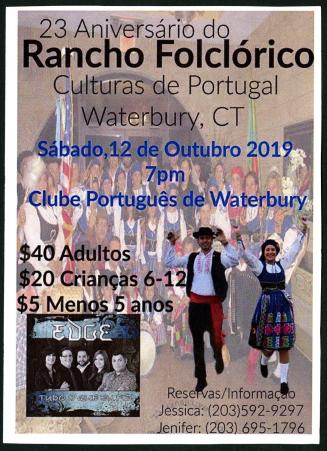Program: Festival of Folklore, 2016
DistributorDistributed by
Portuguese Club of Hartford
(founded 1927)
Date2016
MediumPaper
ClassificationsInformation Artifacts
Credit LineConnecticut Cultural Heritage Arts Program collections
CopyrightIn Copyright
Object number2015.196.61.2
DescriptionProgram for the Festival of Folklore, Portuguese Club of Hartford, 2016.
NotesSubject Note: Connecticut residents of Portuguese descent number nearly 50,000; there is a Portuguese Consulate in Waterbury, signaling the importance of this ethnic group's presence throughout the state. Waterbury, Bridgeport, Hartford, Danbury and Stonington CT have sizeable Portuguese communities with different roots and cultural characters. Portuguese immigrants have come from mainland Portugal as well as the Azores and Madeira islands. Settling mainly in urban areas of Connecticut, they established churches, shops, restaurants and bakeries, and social clubs. Many Hartford Portuguese community members work in health care and hospitals. Those settling near the south coast of Connecticut work in maritime industries. Cultural heritage is maintained strongly in Portuguese communities, seen in many festivals – often religious celebrations with processions – continuing throughout the state. Stonington holds a summer Blessing of the Fleet and Holy Ghost Festival in August, Waterbury celebrates Festa de Sao Joao in June, Naugatuck has the San Paio Festival over Labor Day, Danbury holds the Festa do Senhor Santo Cristo dos Milagres and other events, the Holy Ghost Society in East Hartford hosts a festival on its grounds, and Hartford organizes the Festa do Divino Espiritu Santo, the Festa do Sao Joao and the Day of Portugal, and St Martin’s Day in November (commemorating the crop of chestnuts), among other events. In addition to churches, social clubs in the cities are community centers of language, sports, newspapers, cultural activities, foodways and festivals. For instance, the Portuguese Club of Hartford was founded in 1927. In 2017 the Club suffered a devastating fire and is in the process of rebuilding, but the membership remains strong with a young population.Several Portuguese dance groups exist, most based at Portuguese clubs in different Connecticut cities such as Hartford, Waterbury, Danbury, and Bridgeport. The official dance troupe of Hartford's Club, Rancho Folclórico was formed originally in 1972 by immigrants eager to perform dances and music from their homeland; it is the oldest rancho in New England. Many members of the dance group have been participating for decades, marriages take place and children come into the group, forming family dance dynasties. In 1976, the Rancho were invited to dance at the Smithsonian's Bicentennial celebrations, in 1985, they toured Portugal, performed at the Special Olympics in 1996, and the Lowell Folk Festival in 1997. In addition to dancing at all the local festivals, the group participates in a network of Portuguese dance organizations who perform regularly across the East Coast. In 2019, the group was invited to Bermuda and Canada. The Rancho hosted several visiting Portuguese dance groups from Canada and the U.S. during the Day of Folklore events that drew audiences of almost 500 each year.
Rancho Folclórico strives for authenticity in the dances, costumes, and music presented. Over the years many instructors from the community knowledgeable in traditional music and dance have taught group members. Portugal has three main regions differing widely in geography, the occupations followed by people living there, and their traditions. Regional variations are reflected in the dances, which are very specific to each locality. The situation in America is more complex, as Portuguese communities are comprised of immigrants from different regions. Rancho Folclórico, originally with a membership mostly from northern Portugal, is now broadening its repertoire to include dances from the central region, such as the faster fandango performed by men from Ribatejo.
The group has carefully researched and collected traditional costumes as well as dances. All handmade in northern Portugal, the women's costumes are of two types: heavily beaded black velvet outfits with white veils worn by brides, bridesmaids, or wealthy women, and the brightly colored vests and embroidered skirts worn by village women on festive occasions. The color, style, and width of the embroidered hems vary from parish to parish in the north, identifying the owner by her village. Unlike many groups, Rancho Folclórico women wear xinelo, the embroidered clogs which mark the dance rhythm with their heavy soles but are difficult to keep on the feet. Most men in the group wear the black trousers, white shirts, long red sashes, and beaded vests of northern farmers while leader Joao Santos, who dances the fandango, wears the appropriate knee-length trousers and vest of a Ribatejo cattleherder.
Accompanying the dancers, musicians play accordions, violao (guitar), cavaquinho (mandolin), hand-held frame drum, triangle, and ret ret (a long piece of serrated wood scraped with a stick). In place of drums in the south, a split bamboo stick called caninhas keeps the beat. Male and female vocalists sing festive songs about wine and romance. Northern songs are more melodic, with a fast waltz tempo, while dances in the south are very fast and rhythmic. All Portuguese dances are done by couples; dance movements often suggest local occupations as in vira ("to turn") from the north coastal seafaring province of Minho, or chula and malhao, which are threshing dances. Dancing with raised arms, often with castanets, is a characteristic of Portuguese dance.
(Source: https://www.hartfordportugueseclub.com/rancho)
Additional audio, video, and/or photographic materials exist in the archive relating to this community and these events.
Cataloging Note: This project was made possible in part by the Institute of Museum and Library Services MA-245929-OMS-20.
Status
Not on viewPolish Cultural Club of Greater Hartford
















